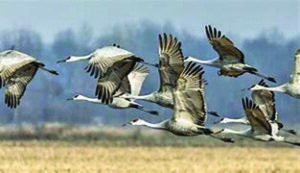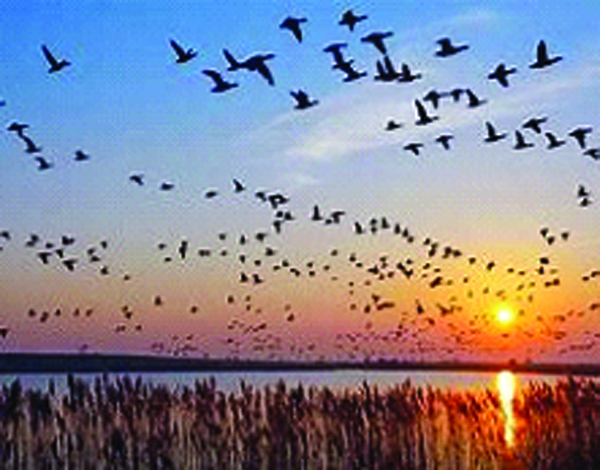I recently heard a keynote talk on Bird Migration by Stan Takiela at the Florida Birding & Nature Festival. As usual, I took copious notes as I do when I attend most talks. Stan also gave a talk the next day on Bird Nest that I attended and devoured.
I have been fascinated by this topic of bird migration for years and recently have taken a particular interest in swallow tail kites and other birds that establish homes in Florida prior to migrating enormous distances, often thousands of miles.
The Florida Birding & Nature Festival is an annual event that takes place in Apollo Beach, Florida. It is a four-day festival that offers a range of activities such as field and boat trips, expert seminars, keynote speakers, and a free nature expo.
Before I take on any writing task, a short essay or a 500 page book, I formulate questions that I want answered. With migration, I had boundless curiosity.
Why and when did migration first begin millions of years ago? How do the birds know when to push off and migrate? If all the species of one bird are spread out all over Florida, such as swallow tail kites, do they all leave at the same time? Do they join up? Do certain birds fly alone and others in massive groups? How many kinds of migrations are there?
push off and migrate? If all the species of one bird are spread out all over Florida, such as swallow tail kites, do they all leave at the same time? Do they join up? Do certain birds fly alone and others in massive groups? How many kinds of migrations are there?
Not all migration are the same. Complete migration is the one that most people think about when it comes to migration. It’s a population of complete migrators where generally all the birds, go perhaps thousands of miles between summer and winter locations at certain predictable times each year. Examples include warblers and tanagers who fly some of the longest distances of any migrator. They are called Neotropical migratory birds because they migrate in the fall from northern states and Canada to spend the winter in the tropics of Central and South America. They make a long journey back to the north in the spring, where they nest and reproduce.
Short distance migrators, such as the eastern bluebird and the American robin generally migrate shorter distances, sometimes only a couple hundred miles.
Why do some birds stay put? Over many years of evolution many species of birds adapt to seasonal changes. They can survive both good and bad times and these non-migrators have physical traits that help these birds to stay and live in extreme weather conditions, traits not found in species that migrate. For example, non-migrators grow 2/3 more feathers during the fall molt than migrators. An example is the black capped chickadee.
There are some birds that exhibit what is called nomadic spontaneity such as the American goldfinch, also called the wild canary. Banding records are used to show that some of these winter in northern states and others enjoy the warmth of southern states; these birds stay wherever food is abundant and move on without any regard to the season.
Certain birds have a complete migration that is vertical. The dusky grouse, a chicken-like bird in the Rocky Mountains region, migrates up and down the mountains. During spring, it moves down to the breeding grounds, which are at low elevations. In the fall, it moves up into the mountains, to the coniferous forest at high elevations. This regular movement, representing up to thousands of feet of elevation change, is also regarded as complete migration.
What are some cues as to why birds migrate? There are internal and external cues.
External cues include changes to the amount of daylight, the availability of food and changes in the weather. They tip the bird off to when it’s time to feed for the trip and later to fly and migrate.
Internal factors have a specific genetic aspect that can best be noted when you look at a species that has individuals living in different region. For example, the peregrine falcon that nests in the southern regions don’t migrate. If they live in the far north, for example, the Alpine tundra, they migrate to spend the winter farther south, so they respond to these external factors along with their genetic programming,
Other species of birds, such as Orchard Orioles and Blooming Warblers leave for migration in the late summer, long before the weather changes, or before food becomes scarce. When there’s still plenty of food, the birds leave their nesting grounds to head south for the winter, relying on a genetic type of internal or endogenous cue for migrating.
How birds navigate is still a great mystery. Although there are many theories that persist over the years, new studies and ideas have helped explain the complexity of bird navigation. More stories on bird migration will be covered in Part Two. Join me for the adventure.
And where can you see bird migration?
Come out into The Great Florida Outdoors
Dr. Norman is an advanced master naturalist graduate of the FMNP program from UF and a board-certified dermatologist based in Tampa and Riverview. He can be reached at 813-880-7546.

70 books (series editor of 39) ● 300+ articles ● 150 Lectures and Blogs
45 videos and films ● 18 photo calendars and exhibits ● 4 music CDs
Tampa Bay Medical Hero Award (2008)
● Hadassah Humanitarian Award (2012)
To order books click on these links:
Trade (Popular) Books
Clinical Books
Instructional Books
Read more of Dr. Norman’s articles here. https://dunndealpublications.com/dr-robert-normans-articles/
